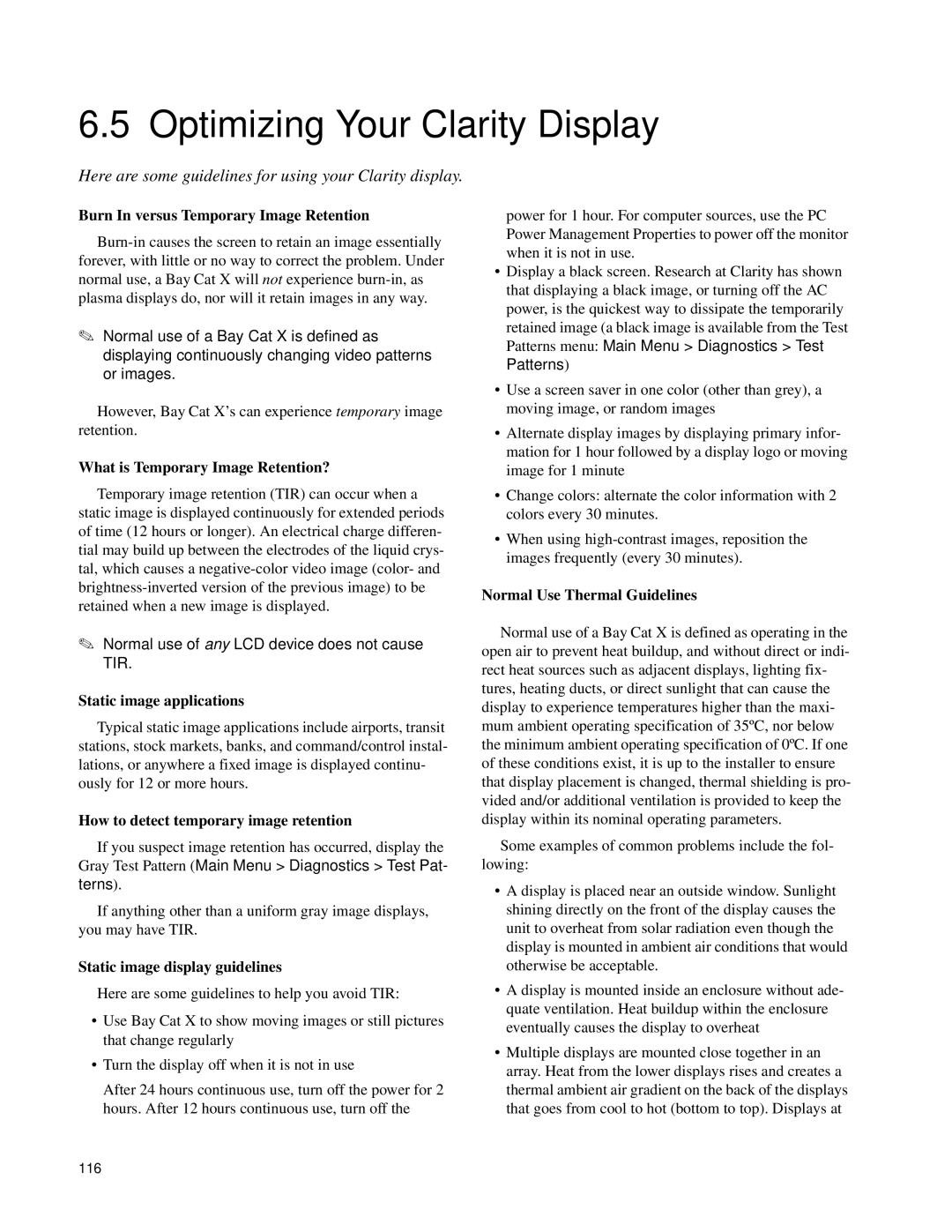6.5 Optimizing Your Clarity Display
Here are some guidelines for using your Clarity display.
Burn In versus Temporary Image Retention
✎Normal use of a Bay Cat X is defined as displaying continuously changing video patterns or images.
However, Bay Cat X’s can experience temporary image retention.
What is Temporary Image Retention?
Temporary image retention (TIR) can occur when a static image is displayed continuously for extended periods of time (12 hours or longer). An electrical charge differen- tial may build up between the electrodes of the liquid crys- tal, which causes a
✎Normal use of any LCD device does not cause TIR.
Static image applications
Typical static image applications include airports, transit stations, stock markets, banks, and command/control instal- lations, or anywhere a fixed image is displayed continu- ously for 12 or more hours.
How to detect temporary image retention
If you suspect image retention has occurred, display the Gray Test Pattern (Main Menu > Diagnostics > Test Pat- terns).
If anything other than a uniform gray image displays, you may have TIR.
Static image display guidelines
Here are some guidelines to help you avoid TIR:
•Use Bay Cat X to show moving images or still pictures that change regularly
•Turn the display off when it is not in use
After 24 hours continuous use, turn off the power for 2 hours. After 12 hours continuous use, turn off the
power for 1 hour. For computer sources, use the PC Power Management Properties to power off the monitor when it is not in use.
•Display a black screen. Research at Clarity has shown that displaying a black image, or turning off the AC power, is the quickest way to dissipate the temporarily
retained image (a black image is available from the Test Patterns menu: Main Menu > Diagnostics > Test Patterns)
•Use a screen saver in one color (other than grey), a moving image, or random images
•Alternate display images by displaying primary infor- mation for 1 hour followed by a display logo or moving image for 1 minute
•Change colors: alternate the color information with 2 colors every 30 minutes.
•When using
Normal Use Thermal Guidelines
Normal use of a Bay Cat X is defined as operating in the open air to prevent heat buildup, and without direct or indi- rect heat sources such as adjacent displays, lighting fix- tures, heating ducts, or direct sunlight that can cause the display to experience temperatures higher than the maxi- mum ambient operating specification of 35ºC, nor below the minimum ambient operating specification of 0ºC. If one of these conditions exist, it is up to the installer to ensure that display placement is changed, thermal shielding is pro- vided and/or additional ventilation is provided to keep the display within its nominal operating parameters.
Some examples of common problems include the fol- lowing:
•A display is placed near an outside window. Sunlight shining directly on the front of the display causes the unit to overheat from solar radiation even though the display is mounted in ambient air conditions that would otherwise be acceptable.
•A display is mounted inside an enclosure without ade- quate ventilation. Heat buildup within the enclosure eventually causes the display to overheat
•Multiple displays are mounted close together in an array. Heat from the lower displays rises and creates a thermal ambient air gradient on the back of the displays that goes from cool to hot (bottom to top). Displays at
116
